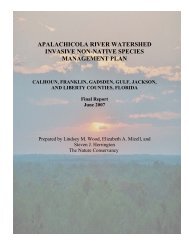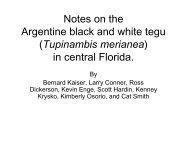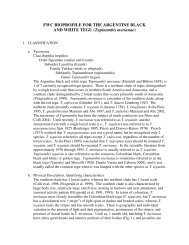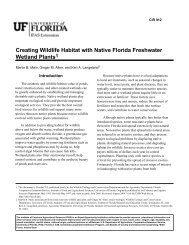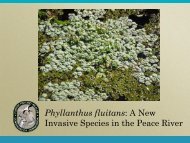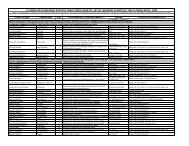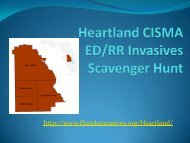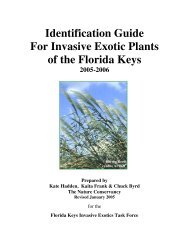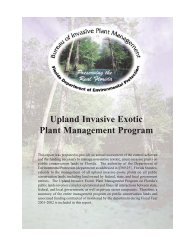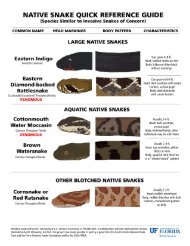Mikania micrantha Kunth: Identification and Survey, 2009 - 2012
Mikania micrantha Kunth: Identification and Survey, 2009 - 2012
Mikania micrantha Kunth: Identification and Survey, 2009 - 2012
Create successful ePaper yourself
Turn your PDF publications into a flip-book with our unique Google optimized e-Paper software.
<strong>Mikania</strong> <strong>micrantha</strong> <strong>Kunth</strong>:<br />
<strong>Identification</strong> <strong>and</strong> <strong>Survey</strong>,<br />
<strong>2009</strong> - <strong>2012</strong><br />
<strong>2012</strong> Andrew Derksen DPI-CAPS
A growing menace?<br />
• Asteraceae<br />
• Genus <strong>Mikania</strong>:<br />
– Herbaceous or<br />
semi-woody<br />
perennial<br />
– Weedy vine<br />
– Hard to ID when<br />
compared to<br />
native species<br />
Andrew Derksen, DPI-CAPS <strong>2009</strong>
Why it matters<br />
• One of the top three<br />
invasive weeds<br />
worldwide<br />
• Federal <strong>and</strong> state<br />
listed pest<br />
• Competes for<br />
access to light<br />
• Secretes allomones<br />
inhibiting plant<br />
growth<br />
Andrew Derksen, DPI-CAPS <strong>2009</strong>
Andrew Derksen, DPI-CAPS 2011<br />
Habitat<br />
• Organic nutrients, air<br />
<strong>and</strong> soil humidity high<br />
• When in flower<br />
– Easier to observe<br />
– Late in winter<br />
• May be temperature<br />
dependent<br />
• Thrives in disturbed<br />
areas<br />
– Fence lines<br />
– Roadsides<br />
– Ab<strong>and</strong>oned property
Description:<br />
leaf<br />
• Leaves are opposite<br />
• Heart-shaped<br />
• Serrate edges<br />
• 4-13cm in length<br />
• 2-9cm in width<br />
• Petiole of each leaf is<br />
2-8cm long<br />
• Hairless<br />
Karolynne Griffiths, USDA-CAPS 2010
Description:<br />
flower<br />
• Glabrous inflorescence<br />
• Greenish-white<br />
• 4 per cluster<br />
• 3-5 mm long<br />
• Floral structure is most<br />
obvious part<br />
© 2008 Konrad Englberger, Secretariat of<br />
the Pacific Community
Description: seed<br />
• Pappus persistent,<br />
one row of 32-38<br />
ivory to light<br />
amber finely<br />
barbed bristles 2-3<br />
mm long<br />
• Style base<br />
inconspicuous<br />
• Apex horizontal,<br />
blackish-brown,<br />
granular<br />
• Embryo linear;<br />
endosperm absent<br />
Julia Scher, USDA APHIS PPQ, Bugwood.org
Means of dispersal<br />
• Seeds act like a<br />
parchute, allowing<br />
ease of dispersal<br />
by the wind<br />
• Hooks allow<br />
movement by<br />
birds <strong>and</strong><br />
mammals<br />
• Produces roots at<br />
nodes, resulting in<br />
dense patches<br />
that are difficult to<br />
remove<br />
Andrew Derksen, DPI-CAPS 2010
Homestead, Florida
Native <strong>Mikania</strong> cordifolia
Native <strong>Mikania</strong> sc<strong>and</strong>ens<br />
Andrew Derksen, <strong>2009</strong><br />
Andrew Derksen, DPI-CAPS 2010
<strong>Mikania</strong>: floral characters<br />
sc<strong>and</strong>ens<br />
<strong>micrantha</strong><br />
Patti Anderson, FDACS 2011
<strong>Mikania</strong>: nodal characters<br />
sc<strong>and</strong>ens<br />
<strong>micrantha</strong><br />
Patti Anderson, FDACS 2011
Initial Detection<br />
• Nov. ‘08: suspicious<br />
weed spotted in<br />
Homestead area, but<br />
not submitted for<br />
identification<br />
• Nov. 23 rd , ‘09:<br />
suspicious weed<br />
submitted to DPI for<br />
confirmation<br />
Andrew Derksen, DPI-CAPS 2011
Florida Response<br />
Late <strong>2009</strong>:<br />
• <strong>Survey</strong> conducted by<br />
DPI <strong>and</strong> CAPS to<br />
obtain additional<br />
samples <strong>and</strong> delimit<br />
area<br />
• Plant Inspection<br />
begins surveying<br />
nurseries <strong>and</strong><br />
institutes quarantine<br />
actions<br />
• Weed in full flower<br />
Karolynne Griffiths, USDA-CAPS 2010
Florida Response<br />
Early 2010:<br />
• FDACS <strong>and</strong><br />
USDA begin<br />
manual<br />
suppression<br />
efforts<br />
• Weed in full<br />
seed<br />
Andrew Derksen, DPI-CAPS 2010
Florida Response<br />
Late 2010:<br />
• Plant Inspection<br />
continues survey<br />
of quarantined<br />
sites<br />
• Ab<strong>and</strong>oned<br />
nurseries<br />
determined to be<br />
signIficant source<br />
Andrew Derksen, DPI-CAPS 2010
Florida Response<br />
Early 2011:<br />
• ECISMA surveys<br />
– Additional<br />
personnel<br />
– Natural areas<br />
• Begin herbicide<br />
treatment<br />
Late 2011:<br />
• Repeat!<br />
Dennis Giardina, FWC 2010
2011 Observations<br />
• Persists in spite of management efforts<br />
• Anecdotal evidence suggests that it is no longer<br />
the most prominent weed in treated areas<br />
• Has not spread as fast as initially expected<br />
• Limited experiments suggest seed viability is low<br />
• Ab<strong>and</strong>oned nurseries remain source reservoirs<br />
for new seed<br />
Andrew Derksen, FDACS 2011
Sonya Thompson, MDC Parks 2010<br />
Obstacles to Overcome in <strong>2012</strong><br />
• Jurisdiction<br />
– Some issues resolved by ECISMA for County<br />
<strong>and</strong> State parks, easements, waterways<br />
• Still need access to private properties<br />
– Ab<strong>and</strong>oned properties<br />
• Funding for<br />
– Herbicide<br />
– Research
Florida Response: IFAS<br />
• Dr. Overholt:<br />
– Maintains list of<br />
putative<br />
biocontrols<br />
• Dr. Sellers:<br />
– Tests efficacy of<br />
herbicides<br />
Andrew Derksen, DPI-CAPS 2011
IFAS: Insect herbivores<br />
• 4 species<br />
of leaf<br />
miners<br />
• Mites
IFAS: Diseases<br />
• Septoria mikania-<strong>micrantha</strong>e<br />
• Cercospora mikaniacola
How you can help<br />
• <strong>Survey</strong> your grounds for this destructive vine,<br />
focusing on fence lines <strong>and</strong> disturbed areas<br />
• Overnight pressed botany samples to:<br />
Dr. Patti Anderson<br />
Division of Plant Industry<br />
1911 SW 34 th Street<br />
Gainesville, Florida 32608<br />
• Call the DPI hotline to report suspicious<br />
locations: 1-888-397-1517
How you can help<br />
• Contact your local<br />
extension office for<br />
herbicide<br />
recommendations<br />
• If you decide to<br />
physically remove the<br />
vine, place in plastic<br />
bags for destruction<br />
by commercially<br />
licensed trash haulers<br />
or bury the rouged<br />
plants on site<br />
Andrew Derksen, DPI-CAPS 2010
Andrew Derksen, FDACS 2011<br />
Questions?



